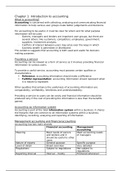Chapter 1: Introduction to accounting
What is accounting?
Accounting is concerned with collecting, analyzing and communicating financial
information to help various user groups make better judgements and decisions.
For accounting to be useful, it must be clear for whom and for what purpose
information will be used.
- Owners, managers and lenders are important user groups, but there are
several others, like customers, competitors, employees, government,
suppliers, investment analysts.
- Conflicts of interest between users may arise over the ways in which
business wealth is generated or distributed.
The evidence suggests that accounting is both used and useful for decision-
making purposes.
Providing a service
Accounting can be viewed as a form of service as it involves providing financial
information to various users.
To provide a useful service, accounting must possess certain qualities or
characteristics.
Relevance: accounting information should make a difference
Faithful representation: accounting information should represent what
it is meant to represent
Other qualities that enhance the usefulness of accounting information are
comparability, verifiability, timeliness and understandability.
Providing a service to users can be costly and financial information should be
produced only if the cost of providing the information is less than the benefits
gained.
Accounting as information system
Accounting is part of the total information system within a business. It shares
the features that are common to all information systems within a business:
identifying, recording, analyzing and reporting of information.
Management accounting and financial accounting
Accounting has two main strands
Financial accounting Management
accounting
Meaning Meet needs of owners Meet accounting needs
and lenders and it of managers
should be useful to other
users
Nature of reports General purpose Specific purpose
Level of detail Broad overview Very detailed
Regulations Subject to regulations Not subject to
regulations
Reporting interval Interval – mostly Produced whenever
, annually needed
Time orientation Reflect on past period Future as well as past
Range and quality of Information that can be Information of a non-
information quantified in monetary financial nature
terms
Less objective and
Use of objective verifiable information
evidence
The changing face of accounting
Changes in the economic environment have led to changes in the nature and
scope of accounting.
Financial accounting has improved its framework of rules and there has been
greater international harmonization of accounting rules.
Management accounting has become more outward looking, and new methods
for managing costs have been developed to help a business gain competitive
advantage.
What is the purpose of a business?
The purpose of business is to create and keep a customer.
What kinds of business ownership exists?
There are three main forms of business unit
1. Sole proprietorship: where an individual is the sole owner of a business,
which makes it easy to set up and flexible to operate, but the owner has
unlimited liability
2. Partnership: where two or more individuals carry on a business together
with the intention of making a profit, which makes it easy to set up and
spreads to burdens of ownership, but partners usually have unlimited
liability and there are ownership risks if the partners are unsuitable
3. Limited company: can range in size from quite small to very small, the
liability of owners is limited, but obligations are imposed on how a
company conducts its affairs
o Limited liability means that those individuals subscribing capital to
the company are liable only for debts incurred by the company up
to the amount that they have invested, or agreed to invest
o This limited liability does not apply to sole proprietorship and
partnership
How are businesses organized and managed?
Most businesses of any size are set up as limited companies.
- Finance will come from the owners (shareholders) in form of direct cash
investment to buy shares and through the shareholders allowing past
profits to be reinvested in the business
- Finance will also come from lenders, who earn interest on their loans
- Finance will be provided through suppliers of goods and services
, A board of directors is appointed by owners (shareholders) to oversee the
running of the business. The board represents the most senior level of
management.
The quest for wealth creation
The key financial objective of a business is to enhance the wealth of the owners.
To achieve this objective, the needs of other groups connected with the
business, such as employees, suppliers and the local community, cannot
be ignored.
When setting financial objectives, the right balance must be struck between risk
and return.
Non-for-profit organizations
These organizations also produce accounting information for decision-making
purposes.
They have user groups that are similar to, or the same as, those of private-sector
businesses.
Chapter 2: Measuring and reporting financial position
Major financial statements
There are three major financial statements
1. Statement of cash flows: shows the cash movements over a particular
period
2. Income statement (or profit and loss account): shows the wealth, profit,
generated over a particular period
3. Statement of financial position (or balance sheet): shows the
accumulated wealth at a particular point in time
Together they provide an overall picture of the financial health of the business.
The statement of financial position
The statement of financial position sets out the assets of the business, on
the one hand, and the claims against those assets, on the other.
Assets are resources of the business that have certain
characteristics:
- It must be an economic resource (provides right to
potential economic benefits).
- The economic resource must be under the control
of the business.
- The economic resource must be capable of
measurement in monetary terms.
Examples that appear as assets in statement of financial
position are property, plant and equipment, fixtures and
fitting, patents and trademarks, trade receivables,
investments outside the business.






